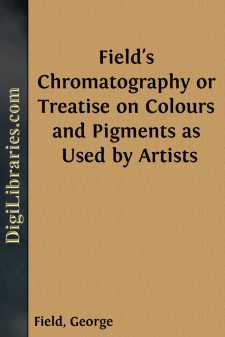Categories
- Antiques & Collectibles 13
- Architecture 36
- Art 48
- Bibles 22
- Biography & Autobiography 813
- Body, Mind & Spirit 142
- Business & Economics 28
- Children's Books 15
- Children's Fiction 12
- Computers 4
- Cooking 94
- Crafts & Hobbies 4
- Drama 346
- Education 46
- Family & Relationships 57
- Fiction 11829
- Games 19
- Gardening 17
- Health & Fitness 34
- History 1377
- House & Home 1
- Humor 147
- Juvenile Fiction 1873
- Juvenile Nonfiction 202
- Language Arts & Disciplines 88
- Law 16
- Literary Collections 686
- Literary Criticism 179
- Mathematics 13
- Medical 41
- Music 40
- Nature 179
- Non-Classifiable 1768
- Performing Arts 7
- Periodicals 1453
- Philosophy 64
- Photography 2
- Poetry 896
- Political Science 203
- Psychology 42
- Reference 154
- Religion 513
- Science 126
- Self-Help 84
- Social Science 81
- Sports & Recreation 34
- Study Aids 3
- Technology & Engineering 59
- Transportation 23
- Travel 463
- True Crime 29
Field's Chromatography or Treatise on Colours and Pigments as Used by Artists
by: George Field
Categories:
Description:
Excerpt
ON COLOURING.
How early, and to what extent, colouring may have attained the rank of science among the ancients, are questions not easily set at rest; but that some progress had been made, even at a very remote period, is proved by the magnificent tombs of the Egyptian kings at Thebes, where the walls of the royal mausoleum are described as being covered with paintings so fresh and perfect, as to require neither restoration nor improvement. So far from this, indeed, that with all care in copying, it was difficult to equal the brilliancy of the originals, which, as far as colours went, threw all others in the background. And yet, in spite of the scale having comprised pure vermilion, ochres, and indigo, it was not gaudy, owing to the judicious balance of the colours, and the artful management of the black. Nor was there an ornament throughout the dresses, wherein the red, yellow, and blue, were not so employed as to produce a delicious harmony.
Moreover, it is stated that in one painting eighty feet high and proportionably broad, which was divided into two ranges of gigantic figures, these were glowing with most exquisite colours, suited to the drapery and naked parts; and in which the azure, yellow, green, &c., were as well preserved as though they had been laid on yesterday. Again, an apartment was discovered among the stupendous ruins at Carnac, on the site of ancient Thebes, one hundred paces wide and sixty deep, completely crowded with pillars, which, together with the ceiling, roof, and walls, were decorated with figures in basso-relievo, and hieroglyphics—all marvellously beautiful and finely painted, and as fresh, splendid and glorious, after so many ages, as if they had just been finished.
In various accounts these colourings of the Egyptians are described in the warmest terms of admiration. The most charming are undoubtedly those on the tombs and temples: others of less merit have been found on the cases and cloths of mummies, and on papyrus rolls; but it is to the patterns on the walls and ceilings of their houses that they seem to have been most partial, and paid the most attention. The ordinary colours employed by them were red, yellow, green, and blue. Of the last there were two tints; black also was common. For white, the finely prepared stone-coloured ground was deemed sufficient. These colours were occasionally modified by mixture with chalk; but were always, or nearly always, applied singly, in an unmixed state. With regard to their composition, chemical analysis has shown several of the blues to be oxide of copper with a small proportion of iron; none containing cobalt. There is little doubt, however, that the most brilliant specimens—those which retain all their original force and beauty in the temples of Upper Egypt after an exposure of three thousand years, consist of ultramarine—the celebrated Armenian blue, possibly, of the ancients. The reds seem for the most part to be composed of oxide of iron mixed with lime, and were probably limited to iron earths and ochres, with a native cinnabar or vermilion....


